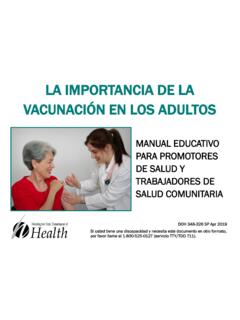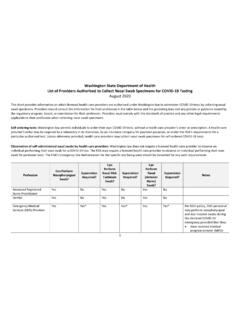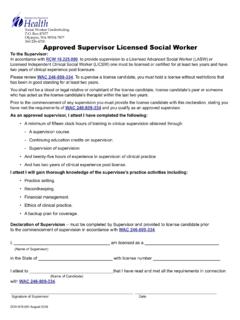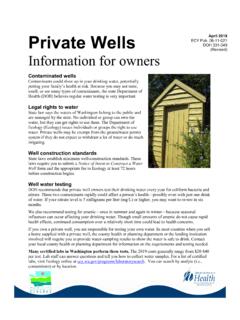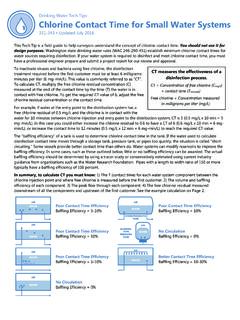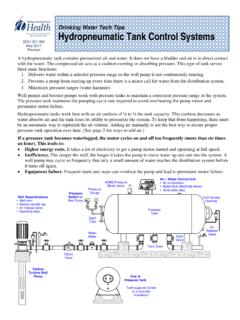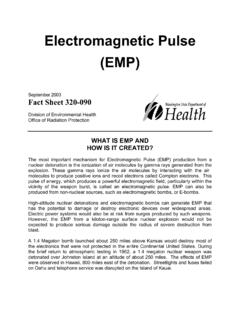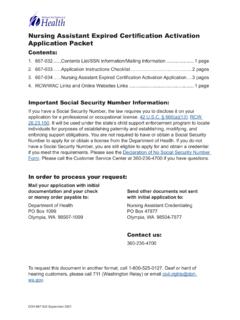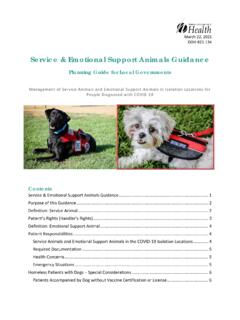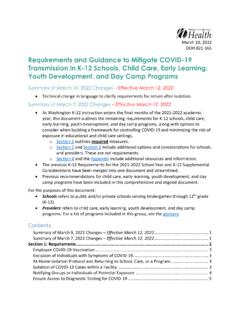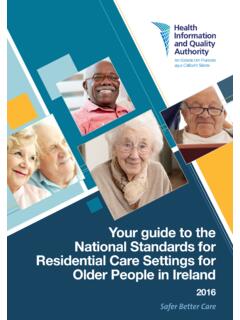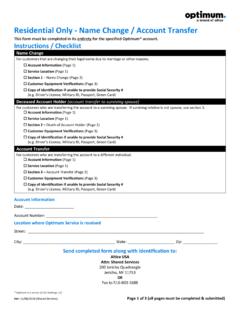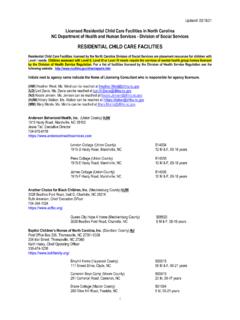Transcription of Interim COVID-19 Outbreak Definition for Healthcare …
1 Updated September 14, 2022 DOH 420-302 To request this document in another format, call 1-800-525-0127. Deaf or hard of hearing customers, please call 711 (Washington Relay) or email Interim COVID- 19 outbreak definition for healthcare Settings Announcement: 9/14/2022: DOH HAI Epi is navigating the updated COVID Outbreak Definition in Healthcare settings posted on the CORHA and CSTE websites. CSTE plans on announcing the change at a webinar on Monday, September 26th. After this announcement, DOH does plan on utilizing the new Definition . The team will provide education and a crosswalk with a date of implementation for WA reporting purposes. For the time being, please utilize the 2020 Definition (see attached below).
2 Update 9/12/2022: DOH HAI Epi is navigating the updated COVID Outbreak Definition in Healthcare settings posted on the CORHA and CSTE websites. For the time being, please utilize the previous Definition for Outbreak identification and reporting purposes. More communication to come, DOH does plan on utilizing the new Definition once CORHA/CSTE has announced and implemented these changes. The DOH implemented the 2020 CSTE COVID-19 Outbreak Definition for Washington reporting as of February 7, 2022. Healthcare outbreaks meeting the Definition should be reported to WDRS. In the link below, refer to the CSTE threshold tables and points of consideration by setting type: Council of State and Territorial Epidemiologists (CSTE) Proposed Investigation/Reporting Thresholds and Outbreak Definitions for COVID-19 in Healthcare Settings WA Healthcare Setting Definitions Hospital (Inpatient).
3 An institution, place, building, or agency which provides accommodations, facilities and services over a continuous period of 24 hours or more, for observation, diagnosis, or care, of two or more individuals not related to the operator who are suffering from illness, injury, deformity, or abnormality, or from any other condition for which obstetrical, medical, or surgical services would be appropriate for care or diagnosis. This category also includes inpatient psychiatric hospitals, critical access hospitals, residential treatment facilities, and inpatient substance use disorder facilities. Long-Term Care Facilities (Inpatient): Nursing homes and skilled nursing facilities Adult family homes Assisted living facilities Enhanced Services Facilities Intermediate care facilities for individuals with intellectual disabilities (ICF/IID) Outpatient: Includes but not limited to emergency departments, urgent care, dialysis, dental, primary care, ambulatory surgery centers, ENT, infusion centers, pain clinics, supported living agencies.
4 To request this document in another format, call 1-800-525-0127. Deaf or hard of hearing customers, please call 711 (Washington Relay) or email For HAI Epidemiology questions, please contact Have more questions? Call our COVID-19 Information hotline: 1-800-525-0127 Monday 6 to 10 , Tuesday Sunday and observed state holidays, 6 to 6 For interpretative services, press # when they answer and say your language. For questions about your own health, COVID-19 testing , or testing results, please contact a health care provider. November 2020 1 Background The thresholds and Outbreak definitions presented below are based on available scientific resources and expert opinion and intended only as guidance for potential adaptation to the local epidemiology of SARS-CoV-2 virus ( COVID-19 ); for example, states and localities may have their own Outbreak definitions and reporting requirements.
5 The information provided here does not replace reporting of COVID-19 as part of state and local COVID-19 surveillance. Suggested thresholds are intended to expedite facilities investigation of COVID-19 cases and reporting to public health authorities, thus ensuring early detection of possible outbreaks and timely intervention to prevent the virus spread. Detailed guidance for investigation of COVID-19 cases is available from Centers for Diseases Control and Prevention (CDC). Healthcare facilities should consult public health authorities if they have questions. 2 Inpatient Setting Thresholds Acute Care Hospitals and Critical Access Hospitals Long-Term Care Facilities (LTCF) and Long-Term Acute Care Hospitals (LTACH) Threshold for Additional Investigation by Facility 1 case of confirmed COVID-19 in a patient 7 or more days after admission for a non-COVID condition; 1 case of confirmed COVID-19 in Healthcare Personnel (HCP)* 1 probable or confirmed COVID-19 case in a resident or HCP*.
6 3 cases of acute illness compatible with COVID-19 in residents with onset within a 72h period Threshold for Reporting to Public Health 2 cases of confirmed COVID-19 in a patient 7 or more days after admission for a non-COVID condition, with epi-linkage ; 3 cases of confirmed COVID-19 in HCP* with epi-linkage 1 probable or confirmed COVID-19 case in a resident or HCP* 3 cases of acute illness compatible with COVID-19 in residents with onset within a 72h period * Healthcare Personnel (HCP), defined by Center for Disease Control and Prevention (CDC), include, but are not limited to, emergency medical service personnel, nurses, nursing assistants, physicians, technicians, therapists, phlebotomists, pharmacists, students and trainees, contractual staff not employed by the Healthcare facility, and persons not directly involved in patient care, but who could be exposed to infectious agents that can be transmitted in the Healthcare setting ( , clerical, dietary, environmental services, laundry, security, engineering and facilities management, administrative, billing, and volunteer personnel)(2).
7 Probable case is defined as a person meeting clinical criteria AND epidemiologic evidence with no confirmatory laboratory testing performed for COVID-19 ; A person meeting presumptive laboratory evidence AND either clinical criteria OR epidemiologic evidence; A person meeting vital records criteria with no confirmatory laboratory testing performed for COVID-19 . (3) Epi-linkage among patients is defined as overlap on the same unit or ward or having the potential to have been cared for by common HCP within a 14-day time period of each other. Epi-linkage among HCP is defined as having the potential to have been within 6ft for 15 minutes or longer while working in the facility during the 14 days prior to prior to the onset of symptoms; for example, worked on the same unit during the same shift.
8 3 Acute Care Hospitals and Critical Access Hospitals Long-Term Care Facilities (LTCF) and Long-Term Acute Care Hospitals (LTACH) Outbreak Definition 2 cases of confirmed COVID-19 in a patient 7 or more days after admission for a non-COVID condition, with epi-linkage ; 3 cases of confirmed COVID-19 in HCP* with epi-linkage AND no other more likely sources of exposure for at least 2 of the cases 1 facility-acquired** COVID-19 case in a resident Points for Consideration An Outbreak response or investigation may take many forms depending on the characteristics of the Outbreak and Healthcare setting. It can involve site visits and facility assessments, collection of additional data that are not captured in standard case investigation or contact tracing, lab- testing of potentially exposed patients and HCP, guidance related to infection control practices including cohorting, and other forms of technical assistance and phone-based consultations involving the affected facility and with public health jurisdictions responding to the Outbreak .
9 Detailed guidance for managing COVID-19 investigations in Healthcare settings is available from Centers for Disease Control and Prevention (CDC)(4). Hospitals may opt to investigate cases of confirmed COVID-19 in patients that are identified fewer than 7 days after admission for a non-COVID condition (for example, 4-5 days). **Facility-acquired COVID-19 infection in a long-term care resident is defined as a confirmed diagnosis 14 days or more after admission for a non-COVID condition, without an exposure during the previous 14 days to another setting where an Outbreak was known or suspected to be occurring. 4 Hospitals that use antigen tests should immediately confirm positive antigen test results in asymptomatic individuals ( , Healthcare personnel tested for routine screening) using PCR and report to public health pending confirmatory testing if investigating a cluster of 3 epi-linked probable cases in patients or HCP.
10 Public health officials may weigh available evidence and consider local conditions when applying the hospital Outbreak criteria. For example, by increasing or decreasing the case thresholds depending on the extent of community levels of COVID-19 , or adjusting the criteria to reflect a combination of HCP and patient cases. Public health officials may wish to offer additional guidance to long-term care facilities about reporting cases or clusters of suspected COVID-19 , tailored to the type of long-term care facility ( , Nursing Home vs. Assisted Living vs. Group Home or other type), including general guidance on reporting of residents with severe respiratory infection that results in hospitalization or death (not limited to those with suspected or confirmed COVID-19 ).
